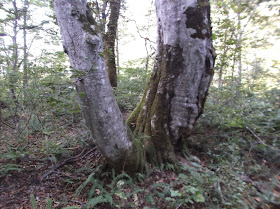Yesterday (Sep. 28), I went mushroom hunting alone for the first time in the season, as requested by my son, who was unable to accompany me because he had to prepare for university entrance exams.
昨日(9/28)は、今シーズン初めて、一人でキノコ狩りに行きました。大学受験のため同行できない息子に頼まれて、です。
First, near the root of this big buna (beech) tree,
まず、この大きなブナの木の根元近くで、
I found these puffballs, hokoritake in Japanese.Hokori = Dust
-take = Suffix meaning mushroom
ホコリタケを見つけました。
To be more precise, they are called tanuki no cha-bukuro (Lycoperdon pyriforme) because they grow on a tree.
Tanuki = Japanese raccoon
No = 's
Cha = Brown
Bukuro < Fukuro = Bag
A similar variety that grows from soil is called kitsune no cha-bukuro (Lycoperdon perlatum).
Kitsune = Fox
正確に言うと、木に生えているので、タヌキノチャブクロと言います。
土から生える似たような種類のキノコはキツネノチャブクロと言います。
I also found some kind of houkitake (Clavaria),
Houki = Broom
ホウキタケの一種も見つけましたが
even my son was unable to identify the exact name.
息子でさえ、正確な名前は分かりませんでした。
I also found this mysterious mushroom on a tree.
この奇妙なキノコも見つけました。
Luckily, I found some honey mushrooms.
運よく、ナラタケを少し見つけました。
As I said several times in my blog, this mushroom is called naratake in Japanese, but
Nara = Oak
it's called amandare here in the Uonuma region of Niigata. It has some other local names, like kuzure and boribori.
このブログで何回も言っている通り、このキノコは日本語ではナラタケと言いますが、新潟の魚沼地方ではアマンダレと言います。他にもクズレ、ボリボリなど地方名があります。
But, yesterday's highlight was definitely these beautiful mushrooms.
しかし、昨日の目玉は何と言っても、このきれいなキノコです。
When I first saw them, I thought they were a kind of mukitake (Sarcomixa serotina), but I wasn't sure. Anyway, I picked them all.
最初に見た時、ムキタケの一種かと思いましたが、はっきり分かりませんでした。とにかく、全部採りました。
As soon as I returned home before noon, I reported to my son that I had found something that looked like mukitake. As soon as he looked at them, he said, "They are tsukiyotake (Omphalotus guepiniformis)". He chided me for being such an amateur...
It is said that tsukiyotake is responsible for a majority of food poisoning cases caused by mushrooms in Japan.
As its name suggests,
Tsukiyo = Moonlit night
this mushroom (underside of the cap) glows faintly in the dark. (I tried to take a photo, but in vain.)
昼前に帰宅してからすぐに息子に「ムキタケに似たキノコを見つけたよ」と報告しましたが、息子はそのキノコを見てすぐに「ツキヨタケだよ」と言いました。素人だなあと叱られました...。
日本でキノコによる食中毒の半数以上はツキヨタケが原因と言われています。
名前の通り、このキノコ(カサの裏側)が暗闇で光ります(写真を撮ろうとしましたが、ダメでした)。
Anyway, my son identified all edible mushrooms. I simply boiled them all for less than two minutes, except the puffballs, which I skewered and grilled in the toaster oven. The boiled mushrooms were put in miso soup, and the grilled puffballs were eaten with lemon juice and soy sauce.
ともかく、息子は食べれるキノコを全て特定し、私はホコリタケ以外は2分未満茹でました。ホコリタケは串に刺し、オーブントースターで焼きました。茹でたきのこは味噌汁に入れ、焼いたホコリタケはレモン果汁と醤油で食べました。











Amazing. How did your son learn about mushrooms?
ReplyDeleteTea Apprentice: Mainly from books. And, we have participated in several workshops on mushrooms so far.
ReplyDeleteDid you find out something about the black mushroom looking like some variety of rameria?
ReplyDeleteThis year took some horrible toll (biggest ever) here because there where lots of mushrooms during the rainy august. Most of the victims where former russian people. They collected a deadly poisonous mushroom, look-a-like to an edible russian mushroom. The news papers printed warnings. Some nubes even started to collect mushrooms using an I-Phone or Android App - dangerous without any knowledge - geez..
Kiki: Luckily (laugh), I didn't find any. Sorry to hear about such terrible accidents. Both Russians and Germans are known to love mushrooms...
ReplyDeleteYesterday, I learned from a TV news program about a man who ate tsukiyotake given by a friend and became sick. The friend mistook tsukiyotake for honey mushrooms! Just unthinkable!
I took some snaps of mushrooms from my last weekend visit to a hill station in Kerala, India. But I did not collect it due to the fear of getting Poisoned by eating it.
ReplyDeleteseeandoh: The iron rules about wild mushrooms are:
ReplyDeleteDo not collect, eat, or give (to anyone) any mushrooms you cannot identify with confidence.